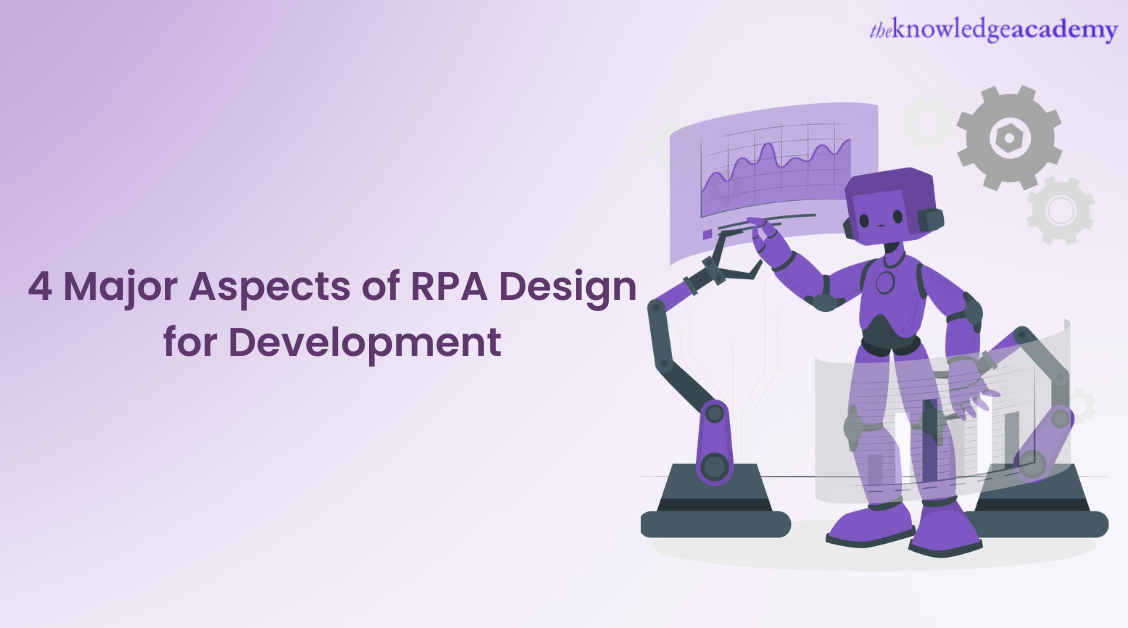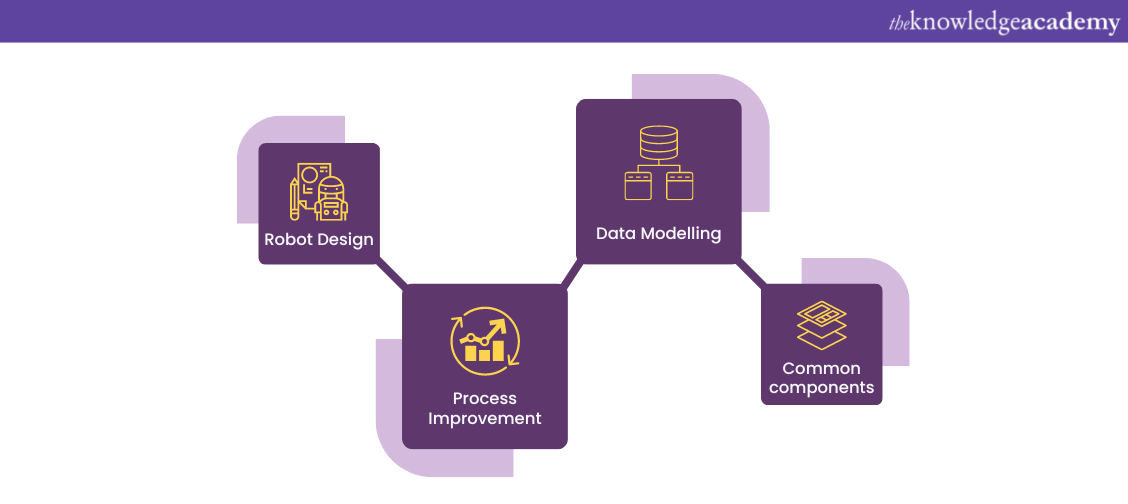We may not have the course you’re looking for. If you enquire or give us a call on +918037244591 and speak to our training experts, we may still be able to help with your training requirements.
We ensure quality, budget-alignment, and timely delivery by our expert instructors.

Business organisations have chosen to dive into RPA lifecycle implementations to discover the benefits as promised by RPA agencies and vendors. On the other hand, RPA initiatives have also faced difficulty fulfilling company objectives. As a result, there has been a desperate call for a curated set of RPA design standards to increase ROI.
According to a global RPA survey by Deloitte, over 50% of participants had already embarked on their RPA projects and anticipated an increase over the coming years. According to the same survey, just about 3% of companies upsized their digital workforce, which illustrates the necessity of trust in design architecture. In this blog, we will learn about the four key aspects of RPA (Robotic Process Automation) designs for business development. Learn more!
Table of Contents
1) Understanding RPA Design
2) Four major aspects of RPA Design
a) Process Improvement
b) Robot Design
c) Data Modelling
d) Common Components
3) Benefits of RPA Design standards
4) Conclusion
Understanding RPA Design
Included in the process of RPA Design implementation, the design phase requires a significant level of focus. The need for carefully planned design results in a few key concerns, which brings to light the skill gap in the market. This skill gap owes to the proprietary aspect of the tool rather than the implementation of RPA as a joint effort between IT and Business services. RPA tools have undoubtedly undergone a significant evolution. However, the architecture and design continue to remain as a few of the most crucial considerations to have successful implementations of RPA.
The requirements for a multi-tiered solution infrastructure involve a few key elements, such as:
1) Process automation of different complexities and degrees
2) Inclusion of both Automation developers and Process SMEs (Small and Medium-sized enterprises) in the implementation process
3) Integrating RPA tools with other major automation technologies like Artificial Intelligence and Data Analytics
4) The simplification of RPA maintenance and development activities and the necessary skill level
5) Promoting reuse of code via the development of internally reusable automation parts or else by utilising third-party parts from marketplaces
6) Extending the usability of the tool for more specific needs and developing custom integrations as a result
7) The solution framework has various layers, such as the Process, Application, Integration, and Tool layers
Four major aspects of RPA Design
RPA Design, similar to any other IT project, follows the Software Development Lifecycle (SDLC), where the process is prioritised, and requirements are gathered. This is followed by an adequate period focused on solution design before any programming or implementation occurs. Overall, every process of automation should involve a solution design document.
A professional with expertise in the technical know-how of RPA tools, automating business processes and the IT landscape in any organisation is referred to as a Solution Architect. This individual takes a macro-view of the platforms undergoing automation and ensures that all are integrated appropriately. The solution architect is also responsible for communicating with investors and solving problems, which are important duties.
Let us have a look at the four major aspects of RPA Design from the Solution Architect’s perspective:
Robot Design
The phase of RPA design must be taken through with utmost care, which takes place in the research phase before any actual programming starts. A crucial element to consider is the robots’ organisational structure while going through solution design to prevent problems in performance. For instance, if a company triggers its RPA bots once daily, the robots must be designed to process every single file on one trigger compared to one file per trigger.
Process Improvement
One misconception in the project improvement phase is to automate the process as it is at a particular moment in an RPA project. This is because automation becomes a tempting action, making the project seem more straightforward in its flow. However, this misplaced automation could make the improper processes uglier. A solution would be considering how the process could be streamlined before entering the automation phase. One de-facto technique is to allow the robot to finish its transaction with fewer screen movements.
Eager to learn more about Robotic Process Automation, refer to our blog on "RPA testing"
Data Modelling
Once the automation process has been streamlined, the data flow between systems must be understood and how it is desirable to structure the data in an aesthetic format. One example could be how a robot can draw out data from an Excel spreadsheet a user has filled. A regulated input template will make the data validation stage much easier. The reason behind this is that validating data helps prevent errors from being displayed, because of which the robot may get chaotic.
Common Components
RPA Design produces bots which are highly capable of scaling fast. This means that redundant actions, like creating the same login function for each process automation, can be replaced by a dedicated RPA bot which automates a hundred processes per application.
During the solution design stage, it must be noted that any step must be usable with little work for the next process, as most automated processes share a common structure. These structures involve login, navigation, data extraction, and so on, which can be reused or copied and pasted in the future. Moreover, scalability translates to fewer hard codes and more dynamic variables during development.

Learn to design and manage RPA solutions and offer automated solutions for your company. Sign up for the Microsoft Power Automate RPA Developer PL500 course now!
Benefits of RPA Design Standards
One characteristic of an RPA bot is that it is designed to work on only one RPA platform, which limits its operability to other platforms. In other words, the RPA ecosystem lacks portability and negligible interoperability, meaning that RPA bots cannot access automation projects on other platforms. Owing to this, process automation details are stated differently by each RPA vendor, obligating users to start the process from scratch if they change vendors.
This expensive and time-consuming process extends to others in the automation chain. As mentioned in the previous paragraph, the RPA system’s drawbacks hinder the process discovery technology from experiencing the impact many anticipate. The reason is that process discovery tools describe process automation in various ways, whether that tool may be a process mining tool or a recorder. Then the processes undergo translation before being deployed on the target RPA platform, which is very costly and time-intensive.
A curation of RPA Design standards would reduce these concerns by setting up a core structure throughout the industry. This structure would set the standard for RPA detail specification for different process automation. A set of RPA standards would effectively remove the necessity of transcribing processes before they can be deployed. Corporations would not have to familiarise themselves with the technical details unique to every RPA tool they face. Automated processes should be ideally designed only once and run across any RPA platform of the company’s choice.
Learn to recognise your software automation goals and perform software testing with Selenium. Sign up for the Software Testing and Automation Training course now!
Conclusion
The existence of universal RPA standards allows organisations to initiate their automation processes across any platform without enduring the hectic process of rebuilding RPA bots from scratch. Different RPA tools speak different languages, and a set of standards enable budget-friendly and quick platform migration. This would let organisations shift RPA vendors for better returns and reduced scaling time.
Gain expertise in Robotic Process Automation using UiPath programming techniques. Sign up for the Robotic Process Automation Using UiPath course now!
Frequently Asked Questions
Upcoming Advanced Technology Resources Batches & Dates
Date
 Robotic Process Automation using UiPath
Robotic Process Automation using UiPath
Thu 10th Apr 2025
Thu 12th Jun 2025
Thu 14th Aug 2025
Thu 9th Oct 2025
Thu 11th Dec 2025






 Top Rated Course
Top Rated Course



 If you wish to make any changes to your course, please
If you wish to make any changes to your course, please


